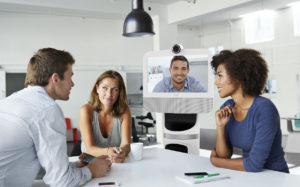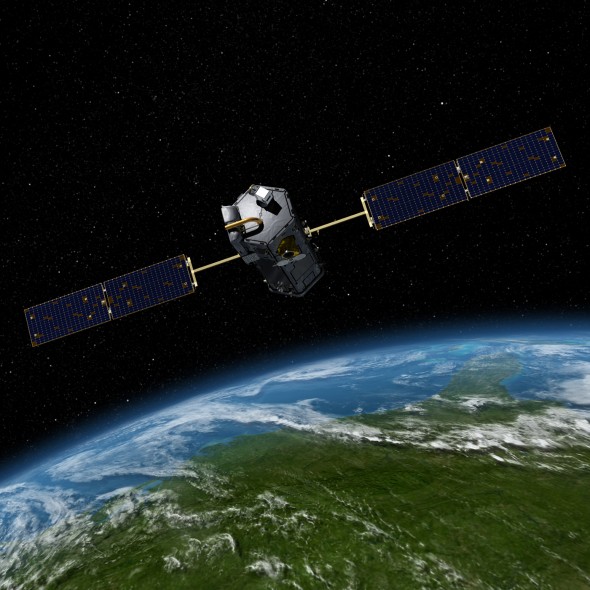
Ava Robotics Introduces Autonomous Telepresence Robot
Founded by ex-iRobot engineers, this startup is building a remote presence robot powered by sophisticated sensors and autonomous navigation

Seven years ago, iRobot introduced us to Ava, a sort of tech demonstrator designed to show how robots were capable of doing things like—well, the company wasn’t entirely sure, but telepresence was one of the ideas. The robot’s autonomous navigation was certainly impressive, and Ava could avoid moving obstacles at the speed of a brisk walk, which wasn’t something we’d seen a lot of back in 2011.
In 2012, iRobot announced RP-VITA, a medical telepresence robot based on the Ava platform. And in 2013, iRobot and Cisco collaborated on the Ava 500, a commercial telepresence system with integrated autonomous navigation. We haven’t heard too much about it since then, but today a startup called Ava Robotics is coming out of stealth mode to announce its plans to bring the technology behind Ava to market.
Ava Robotics, based in Cambridge, Mass., was founded by former employees of iRobot, which holds a minority position in the startup. Ava has licensed some key remote presence technology from iRobot and wants to (re?)launch the Ava platform as a “new video collaboration solution that offers users ‘practical teleportation’ with the ability to transform remote work and site visits.” A telepresence robot, in other words.
What sets Ava apart from other telepresence robots is autonomy. It can map the environment that it’
s deployed in, and then remote users can send it from place to place without having to drive it around by hand. It
’
ll avoid people and obstacles by itself, and even if you do decide to drive it around by hand, it
’
ll still do its best to keep you from running into things.
“Autonomous robotic telepresence solutions such as Ava can have a dramatic impact on improving productivity and collaboration in a geographically diverse global enterprise,” Colin Angle, chairman and CEO of iRobot, said in a statement.

And instead of developing its own custom video streaming technology, Ava again collaborated with Cisco to implement the Cisco Spark video conferencing system into the robot. “We’ve drawn upon iRobot’s 25-year history in robotics innovation to deliver what we call ‘practical teleportation,’ and we are pleased to be part of the Cisco ecosystem in bringing this solution to enterprise customers,”
said Youssef Saleh, Ava Robotics CEO.
The press release didn’t include a lot of detail, so Marcio Macedo, Ava cofounder and VP of products and marketing, answered some of our questions via email. We’d still like more details, in particular about the sensing, navigation, and mapping capabilities of Ava, so hopefully we’ll be able to get a demo and take a close look at the robot sometime soon.
IEEE Spectrum: Why did Ava Robotics spin off from iRobot?
Marcio Macedo:
With iRobot’s strategic focus shifting to home products, Ava Robotics can operate independently and better address the needs of the nascent markets for autonomous robots in commercial spaces. Ava Robotics is born out of iRobot’s long-term investment in autonomous robots that can coexist with humans in both work and public spaces, and iRobot is a significant shareholder in Ava Robotics.
We first met an Ava technology demonstrator at CES 2011. Can you describe how the platform has evolved since then into the commercial product that it is now?
A lot has happened since then. We have improved the solution based on hundreds of real-world installations in commercial spaces such as offices, hospitals, hotels, manufacturing floors, etc. and have enhanced the navigation to the point where humans are very comfortable working alongside Avas. And at the same time, we have evolved the platform to also fit into an enterprise’s digital space: robust wireless, end-to-end data security, APIs for integration, and more.
What kind of local infrastructure is necessary for Ava to operate effectively?
Ava autonomously navigates the space based on what its sensors see of the site’s architectural features, and no accommodations (such as beacons) are necessary. As a video collaboration solution, we do suggest provisioning of strong Wi-Fi and a good internet connection for optimal experience.
What hardware and software does Ava use to map its environment and navigate? Can it manage elevators, and how does it deal with glass walls?
In order to map and navigate large commercial spaces (such as offices, manufacturing facilities, hotels, etc.), Ava combines a 3D depth camera, lidar, and inertial measurement unit, and software developed at iRobot with many years of experience in the real world.
Is the platform being launched different from the iRobot Ava 500, and if so, how?
We learned a lot from the Ava 500 video collaboration robot and, based on feedback from our enterprise customers, have incorporated even more ease of use, collaboration and mobility features into Ava. Three areas of specific enhancement are:
- More immersive user experience with the addition of multiple high definition cameras and improved audio;
- Integrated Cisco Spark video conferencing, with better video quality and integration into enterprise communications;
- Significantly lower cost of ownership.
How much does Ava cost?
Ava is available for delivery now, and customers can implement an Ava Video Collaboration Solution starting at less than US $1,000/month.
In terms of competitors, Ava Robotics will clearly go head-to-head with Suitable Technologies, which has been developing advanced telepresence robots for over five years. Suitable’s offerings include the Beam and BeamPro models, and this summer it will start selling the new BeamPro 2.
But while it’s tempting to simply compare the tech specs of the BeamPro and Ava, Suitable has a much different philosophy on telepresence than Ava does. This is from our recent interview with Bo Preising from Suitable:
We find that having the user move the device around helps keep them engaged in the remote environment and thus allows the device to be perceived as the user more readily by the “locals,” or people who interact with the device.
It’s almost like Suitable wants Beams to be remote embodiments of users, while Avas are more of a focused productivity tool. Based on the lineage of both robots, this makes sense: Beam started out as Texai, designed to give remote presence to one particular employee at Willow Garage. Ava, on the other hand, is more about efficiency, as we saw with RP-VITA—doctors can use the robot to talk with patients, and then spend their time doing other important things while the robot navigates itself to the next appointment.
There isn’t necessarily a “correct” approach here, and it seems likely that the market for high quality telepresence is large enough to sustain several different options. However, as we pointed out in our BeamPro 2 article, it’s not clear how telepresence will fundamentally improve over the next few years. Having competition like this will hopefully force companies to innovate, finding new use cases and creating more compelling telepresence experiences.
[ Ava Robotics ]
Updated 4:10 p.m. ET: Ava Robotics was founded by former iRobot employees and has received investments from iRobot but is not an official spinoff of the company.

Leave a Reply